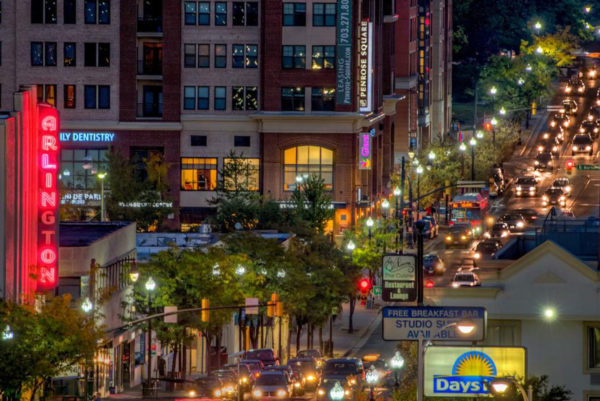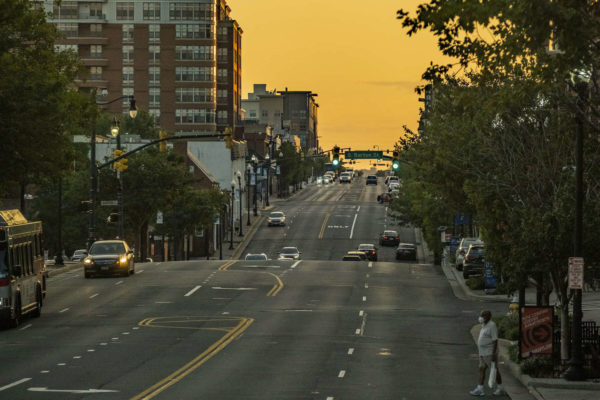
An earlier version of this feature article was published via email for members of our ARLnow Press Club, whose support makes more in-depth reporting like this possible. Join the Press Club here.
The past, present, and future of Columbia Pike is rather easy to see.
Cross Glebe Road and there’s the Broiler, first opened in 1959 and, today, still slinging cheesesteaks. Right by the ramp to I-395, the historic Johnson’s Hill neighborhood (also known as Arlington View) remains home to a number of the same residents that have lived there for decades.
Drive the Pike from Washington Blvd to where it crosses Leesburg Pike in Fairfax County and you’ll see a number of low-slung businesses and massive apartment complexes that were built during the Eisenhower administration.
But, over the last decade, the Pike has seen plenty of change. There’s now modern shopping plazas, cavernous parking garages, and gleaming new apartment complexes. Sure, there’s no streetcar, but in frequent intervals buses go up and down the Pike, pausing at a million dollar bus stop (and, soon, numerous upgraded but less expensive stops).
The Pike has continued to have a reputation for being one of the more affordable areas to live in Arlington and, with that, a diverse neighborhood has thrived. The Pike — and its corresponding 22204 zip code — is often referred to as a “world in a zip code.”
At the same time, the future is nearly here and it may bring changes that not everyone is happy with — or could afford. Redevelopment of decades-old shopping centers, forcing the closing of long-time legacy businesses. Garden-style apartments are being turned into 400-unit buildings. Mixed-use projects are set to replace under-used parking lots.
Not to mention, just a few miles away, Amazon is building a headquarters which is likely to bring more people and development to the Pike.
Today, about 41,000 people live along the Pike corridor, according to county data. That’s more that a 10% increase compared to a decade ago. Over the next thirty years, much of Arlington’s population growth is expected to be concentrated along the Pike.
Officials are looking to adapt to these changes by turning Columbia Pike into what the county calls a “vibrant… walkable, lively ‘Main Street’, an effort that first began more than 30 years ago.
In 1986, the Columbia Pike Revitalization Organization formed in response to the Arlington County Board providing a $50,000 grant towards economically reviving the Pike.
The grant and the formation of CPRO would be, as the Washington Post described at the time, “the first step in what some see as a 10-year effort to coordinate improvements that could lead to revitalization of the highway as well as a return of community pride.”
That was followed over the next decade plus by a number of revitalization plans, policy changes, and initiatives – including in 1990, 1998, and 2002 — all in an attempt to bring more businesses, “revitalize,” and create a more “vibrant” Pike.
But one of the most consequential shifts in what the Pike would look like going forward was the Board’s approval of the Columbia Pike Form-Based Code for commercial centers in 2003 and, a decade later, for residential areas.
“It really gave us a bit of a blueprint on how we were going to move forward,” CPRO Executive Kim Klingler tells ARLnow.
The purpose was to standardize how new buildings along the Pike were physically going to look and integrate into the community.
“It focuses on the form of the building, which is a little different from the way that other zoning codes work,” says John Snyder, Chair of CPRO’s board. “Like, how tall is the building? What’s the shape? [How many] setbacks from the street? How many stories should it be? [The code] puts together all the rules about that… it’s all set in advance.”
The intent was to “foster a vital main street” with mixed-use buildings that had shops, cafes, and other commercial uses on the ground floor and residences and offices above. It also encourages more sidewalks, trees, and public spaces (like Penrose Square).
The hope is to create a more dense, pedestrian, and public transportation-friendly community.
“A walkable community, like a traditional downtown,” says Snyder.
The plus of following a form-based code for the community is that it is known what new buildings are going to look like and avoids a potential years-long battle with a developer over details like height and design.
For the developer, adhering to the code provides incentives like more density and less red tape.
When first adopted, the county was one of the first jurisdictions in the country to use this strategy to redevelop existing, older neighborhoods.
For the most part, proponents say it has worked. While developers can choose whether they adhere to the code, more than 90% of the new buildings along the Pike were developed with it according to Snyder.
“We’ve gotten 12 or 13 new projects, gained some plaza areas we didn’t have before, and we got ground floor retail,” he says. “We got economic revitalization.”
But with economic revitalization, comes other challenges.
With more amenities, a neighborhood becomes more attractive and vulnerable to natural market forces.
“The whole idea for a building like Centro was to build one that has amenities like you’d expect on [Metro’s] Orange Line, except cheaper,” says Snyder. “Because it is close to everything… it drives prices up. And that puts pressure on the affordable apartments.”
While the county has made efforts to preserve and increase affordable housing along the Pike, not all of their proposals have been embraced by the public as good enough.
It isn’t just about rental units, either. Economic revitalization can drive up housing costs and potentially prevent those in the middle-income brackets from buying homes in the community.
While there are a lot of reasons why the Arlington housing market is hot right now, the redevelopment of Columbia Pike is a factor.
“[Housing] prices are definitely up and… can change the tone of a neighborhood,” says Snyder.
The county’s Missing Middle Housing Study is diving into how to address this challenge, but solutions may be hard to come by even if everyone wants to preserve a community that’s accessible for all.
“The goal has always been for the Pike to be a very diverse community — culturally, socioeconomically, and generationally,” Klingler told ARLnow. “We still want to make Columbia Pike a place for all people.”
But is that even possible? Some certainly don’t think so.
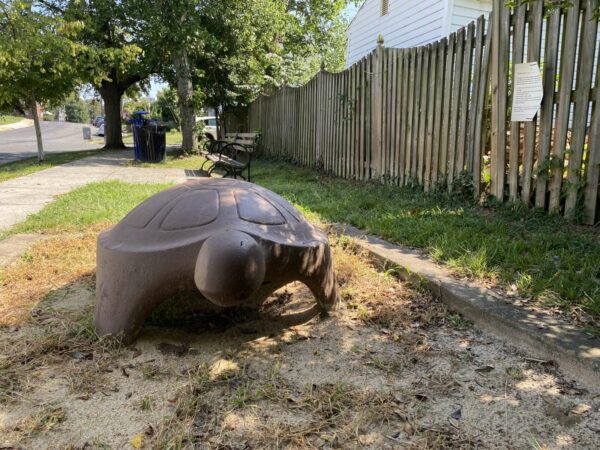
Brenda Cox has lived in Johnson’s Hill, one of Arlington’s historic Black neighborhoods, since 1959. It was a place full of love and inclusiveness, she said.
“We were a community and supported each other,” said Cox, who’s the great-granddaughter of a freed enslaved person. “We fought for rights and people fought for a better life.”
Through the 1960s and 1970s, all the residents of Johnson’s Hill were Black, according to independent data. That began to shift in 1980. In 2010, Black residents made up about two thirds of the neighborhood, according to the county, and that’s likely to decrease more so when census neighborhood data is unveiled.
This is the result of a number of familiar reasons: a younger generation moving away, a county population that’s diversifying, and rising housing prices.
Either way, it has made Cox feel like her community is growing smaller, literally.
“There are now $750,000 townhomes right in my backyard,” she says. “I got a fence since my property divides that.”
For those like Elder Julio Basurto, their long-time home isn’t simply shrinking — it’s being pulled out from under them.
Baustro has lived in the Pike corridor his whole life, but lack of affordability, housing, and safe living conditions is forcing his hand.
“I grew up here, been here since I was five years old. I went to the schools in Arlington,” he said. “But with the [rent] prices that are here now, I feel like certain populations are being pushed out… it’s been a challenge to stay here.”
Twice over the last pandemic year, Basurto had to vacate his Columbia Pike apartment due to repairs, leaks, and mice. He no longer lives along the Pike, the place he called home for decades.
Community leader Janeth Valenzuela works with community members to secure housing along Columbia Pike. It has become increasingly more difficult, she told ARLnow.
“The process to [get] an apartment is even harder than before,” Valenzuela says. “[Property owners and landlords] are scrutinizing everything. They want to know everything.”
Valenzuela believes this is the case because landlords see an opportunity, with all the development, to bring in residents who can pay higher rents. She also blames Amazon’s arrival and the headquarters’ proximity to the Pike.
“It’s becoming more expensive to live in Arlington,” said Valenzuela. “My fear is that we’re going to end up like San Francisco or Seattle.”
Even for a Pike landmark like the Broiler, the future isn’t assured.
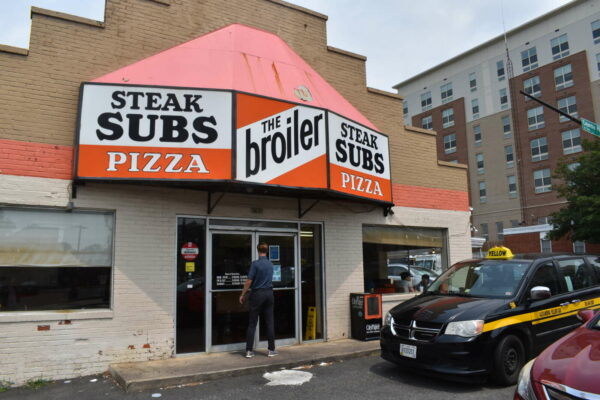
Irv Zetlin opened the steak and cheese spot in 1959, after serving in the Army. At a time when some parts of Arlington weren’t welcoming to everyone, Zetlin said the Broiler served all.
“The [Black community] sometimes didn’t feel comfortable coming to the Pike,” said the now 88-year-old Zetlin. “But they all came to the Broiler.”
The restaurant did well for Zetlin and his family, an example of how a small business can be mutually beneficial for the community and its owners.
“It gave me a good living,” Zetlin told ARLnow.
He sold the Broiler to Chali Elayan in 2000, who has kept the Pike institution close to what it’s always been.
“We’ve tried our best to keep it consistent for the past 20 years we’ve been here,” Chali’s son and now manager Ahmad Elayan. But as Elayan looks out at the Broiler’s decades-long home, Columbia Pike, he doesn’t know what comes next.
“There’s definitely gentrification going on,” Elayan says. “That’s just how business… and capitalism works.”
Zetlin owns the land below the Broiler, which is valued at nearly $1.2 million. He’s not selling yet, but understands the value.
“Eventually somebody is going to want to come along and put a six story building on it,” said Zeitlin.
Elayan said until that happens, the Broiler will continue to grill steak.
“That’s the plan for now. For as long as we can,” he said.
There are visions of the not-so-far-off future that could benefit many. The enhanced bus service, including the eventual inclusion of the high-frequenfy Metrobus 16M line, is one of those.
“I think from a routing standpoint, it’s a pretty good set of bus routes. Once we get [every planned route], we will have a bus that will take you to every color of the Metro line,” Arlington Transportation Commission chair and long-time Pike resident Chris Slatt said.
Making the Pike more pedestrian and bike-friendly are also options that could enhance and make the neighborhood more accessible, Slatt noted. That’s the goal of the Columbia Pike Multimodal Street Improvements project.
“A perfect Columbia Pike would be one where you didn’t have to own a car, where you could get where you need to be by fast, frequent bus service, walking, biking or taking a scooter,” Slatt said. “I would like to see the Pike to retain its sense of community and diversity, while still being some place where you can walk to everything you need.”
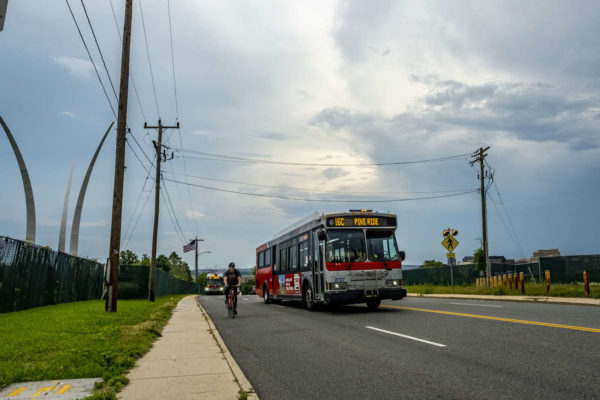
Nearly everyone will say that they want Columbia Pike to remain diverse, provide a sense of community, and be a place everyone who wants to can call home. But that’s easier said than done, with longtime businesses closing, redevelopment happening, and families being pushed out by rising rent.
Local officials say they recognize this.
“We definitely realize that the biggest vulnerability for businesses is during redevelopment and transition… because it can displace retailers,” Arlington County Board member Katie Cristol told ARLnow in an interview earlier this summer. “Which is pretty traumatic.”
Klingler insists that the Pike is and will continue to be a place for all.
“The Pike is just going to blossom ten years down the road,” she said. “But I want to make sure that all of these new people that are coming to the Pike know about the history, the diversity, and the treasure that is Columbia Pilke.”
To do that, admits Klingler, more changes are necessary.
“We need to put our policies and our money in alignment with what we are saying,” she said.


